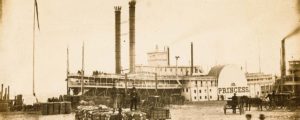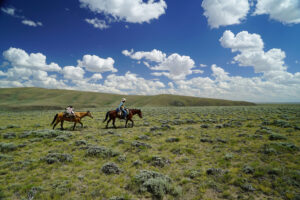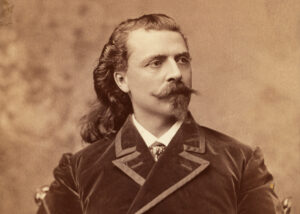Padre Antonio José Martínez dared to speak out against Anglos and the French bishop, making him a sore thumb in this land with few priests.
History is written by the victors. Great heroes can be lost and have even their purest motives denigrated. To make themselves appear great, the triumphant often choose to magnify the villainy of the defeated. In the mid- 1800s Padre Antonio José Martínez held power difficult to imagine today. This made him a target for Anglo leaders and French clergymen. They described him as clutching for power and implied he was immoral. French-born Jean-Baptiste Salpointe, bishop of Arizona and archbishop of Santa Fe, largely omitted Padre Martínez from his 1898 history of the Catholic Church in New Mexico despite the fact the padre had established the region’s first school for both genders, printed its first books, educated the first native priests and bridged a period when New Mexico was almost completely without priests. To understand Martínez, we must comprehend his time and place and what he was defending. In this light his motives appear more pure.
We picture New Mexico, when Brig. Gen. Stephen W. Kearny’s army arrived in 1846, as a priest-ridden land full of fat friars who took their ease at the gambling halls and bordellos of Santa Fe. The parish priest of the Villa Real de la Santa Fé de San Francisco de Asís may have taken his ease in this manner, despite being an old man. The priest of a neighboring town might even have joined him on occasion. But there were no friars in New Mexico in 1846, fat or otherwise, and few priests. Controlling religious observances was the mysterious and secretive brotherhood of Penitentes (“Penitents”), a lay organization proscribed by the Catholic Church for its excesses. During Holy Week the brothers whipped and otherwise tortured themselves in public. Others dragged a cart full of heavy stones atop which sat the skeletal figure of Doña Sebastiana, representing death, bearing her bow and arrow. The cart’s ungreased axle and wheels squealed and skidded over the road to shrill tunes played on the pito, a small flute. In the final ritual a brother depicting Christ was roped to a cross, hoisted aloft and left to suffer, sometimes to the point of unconsciousness.
The ecclesiastical power shift began centuries before when the Spanish crown gave New Mexico to the Franciscans as a mission field, paying for the friars’ upkeep from the royal treasury. At first there were no secular priests (those not associated with a monastic order), only the missionaries who sought out the Pueblo Indians in their villages. Only much later, in 1797, did New Mexico become part of a secular diocese, with parish priests at Albuquerque, El Paso del Norte, Santa Fe and Santa Cruz de la Cañada. Through 1821, when Mexico won its independence from Spain, these secular priesthoods were seldom filled, and the Franciscans also found it difficult to find friars for the northern frontier. New Mexico became a land with few priests and was soon to have even fewer.
A lay brotherhood of obscure origins, la Santa Hermandad (“the Holy Brotherhood”) has gone by many names. Anglos called them the Penitentes due to their penitent rites of self-abuse. Franciscans disavow the group, which has often been confused with the Franciscans’ lay Third Order, whose brothers practiced a private and gentler form of self-flagellation. When the Hermandad first came under public scrutiny in the early 19th century, it was already old, perhaps as old as the conquest, and widespread. Its rituals closely resemble the Holy Week observances of a society in Seville, Spain, but the route of transmission is unknown. This secret society of mutual aid and assistance is similar to the Freemasons, binding society together beyond family and across class lines. In the absence of priests, the brotherhood thrived in New Mexico as a source of succor and religious observance.
But the Hermandad had a dark side. Members of this secret society appeared hooded in public processions as they whipped themselves until blood ran. Onlookers likely wondered what such self-abusing fanatics might do to outsiders. While they punished brothers severely for minor infractions against other brothers, they overlooked major crimes—even murder—when the victim was an outsider.
As populations grew, the Catholic Church created additional parishes at Taos, Abiquiú, San Miguel and Tomé, but the priesthoods often remained unfilled; rarely were there more than two secular priests in all of New Mexico. In this was a mercy for the poor of New Mexico. As the crown was paying the Franciscans’ expenses, there was no mandatory tithe. Thus New Mexicans had grown accustomed to forgoing the tithe. In the absence of that income, secular priests charged parishioners high “stole fees,” payments for ceremonies like baptism, marriage and last rites. But people soon found ways to avoid even these. A baby who might soon die, they reasoned, didn’t really require baptism, and a formal wedding was an extravagance; instead they would save for the truly necessary— last rites. Then, in 1828, the Mexican government, mistrusting the predominately Spanish monks, drove out the Franciscans, leaving New Mexico with only two priests. In this vacuum of religious leadership, the self-supporting Penitentes flourished.
Representing the Catholic Church were a priest in Santa Fe and Padre Antonio José Martínez in Taos. In 1833 the departing Franciscans appointed Padre Martínez to watch over their lay brotherhood, Terciarios de Penitencia (“Third Order of Penance”; the first two orders were of friars and nuns). At the time the Terciarios were in disarray, while the Penitentes were growing in political influence. Padre Martínez, perhaps unable to distinguish between the two lay brotherhoods with oddly similar names, seems to have taken charge of the dominant Penitentes.
The Penitentes are associated with the Santuario de Chimayó, about 25 miles north of Santa Fe. Its founder brought a peculiar belief system, the cult of Our Lord of Esquipulas, from Guatemala, which included the unusual practice of geophagy—eating clay (considered by pilgrims tierra bendita, or “blessed earth”). A leader of the local Penitente group built the chapel sometime before 1810. The Hermandad was already coming to prominence, and its symbols appear prominently on the altar screen. The santuario became a pilgrimage site and is known today as the “Lourdes of America.” At Easter the Penitentes come to practice their Holy Week rites, and pilgrims walk all night from distant towns to hear Mass. Many leave behind their crutches, having seemingly been healed. Others take home dabs of clay from an opening in the floor of a room just off the sanctuary. They mix it with food or sprinkle it on window and doorsills to ward off brujos (“witches”). This religion of the Río Arriba (the region north of Santa Fe) is unique in North America.
Such beliefs had a powerful hold in early New Mexico. In the 18th and early 19th centuries education was the purview of a few ricos, the rich, who could afford to bring tutors into their homes. Elsewhere priests often taught at village schools, but New Mexico lacked priests. There were no printing presses and no newspapers, as there were few who could read them.
Antonio José Martínez was born at Abiquiú in 1793 to one of the wealthiest families in the Río Arriba. His family soon moved to Taos. Young Martínez married in 1812, but his wife soon died, leaving him a baby daughter. In 1818, the child installed with family, he entered seminary in Durango, Mexico, seeking a secular priesthood. He was present for the excitement and hope of the Mexican War of Independence while maintaining a good academic record. Mexican leaders framed a new constitution that incorporated ideas from the Norte Americano experience. Soon after Martínez returned home an ordained priest in 1823, his daughter died. The padre immersed himself in his work and within a year held the parish of Don Fernando de Taos. There he preached the ideals of freedom and castigated the gringo mountain men who finagled Mexican land grants—in competition with his family interests—and who provided the area’s nomadic Indians with guns, powder and intoxicating Taos “lightning.” Chief among such interlopers were Charles and William Bent, who in partnership with fur trader Ceran St. Vrain ran Bent’s Fort and other interests.
The Río Arriba was not the Río Abajo, the land south of Santa Fe, realm of haciendados ricos and their debt-slave peones. The men of the north were free, if poor. They possessed their own lands, plowed the earth with forked tree limbs and shared water, wood lots and grazing commons. Water and commons governed their lives and their natures. In such circumstances one who does well must be stealing from his neighbors, and only a brujo would do that. By politicking among his neighbors a man might win respect and honor, but there were great disincentives to advancement in agriculture or business. The land was cut off from trade, being farther from Mexico City than from St. Louis. Mexican tariffs were high, and the people were metal poor, denied tools and discouraged from manufacturing by a system geared to support only manufacturers from Spain or, later, from the Valley of Mexico. The elevation was high, and the growing season short. In the early 19th century there were few Hispanic towns—Santa Fe, Santa Cruz de la Cañada, Chimayo and Don Fernando de Taos. Most of the remaining towns were Indian Pueblos—Taos, Picuris, Santa Cruz, San Juan, Pojoaque, Nambé, San Ildefanso and others. Abiquiú, Las Trampas and Truchas were genízaro towns. Genízaros were nomadic Indians, captured and held as slaves. Their Spanish masters baptized them and gave them religious instruction, then provided them land grants on the periphery of the settlements, which they were expected to farm and defend. The people of the Río Arriba lived their lives in great isolation from the outside world.
Padre Martínez arrived like a thunderbolt. In 1826 he opened the first enduring school, accepting students of either gender. In 1834 he acquired and operated New Mexico’s first printing press, using it to create books for his school. (As the only press in the region it continued to turn out books and government documents, including the 1846 Territorial Constitution.) Martínez also taught preparatory seminary classes. By 1852, when Bishop Jean-Baptiste Lamy arrived to organize the first diocese of New Mexico, 18 of its 22 priests were former students of Padre Martínez.
In 1832, in the first visit to New Mexico by a bishop in more than seven decades, Bishop José Antonio Zubiría of Durango visited his far-flung diocese and was shocked by what he found. The iconic carvings of local santeros (“saint makers”) offended him, as did the retablos (devotional paintings) of local manufacture. Recognized today as works of art, they were too crudely fashioned to please the bishop, and he ordered them removed from the churches. Even more shocked by the rites of the Penitentes, he promptly proscribed the brotherhood. With the bishop safely returned to faraway Durango, Padre Martínez chose to ignore his orders and support local art and customs.
Then came political upheaval, in 1835, when President Antonio López de Santa Anna suspended the Mexican Constitution of 1824 and replaced it with the Siete Leyes (“Seven Laws”), seeking to strengthen the central government. His action would lead to rebellion in Texas, New Mexico and California. Under the new measures New Mexico became a department governed from Mexico City rather than a self-governing territory. It was rumored high taxes were to follow. The appointed governor, Albino Pérez, was subject to excesses of living and spending, calling forth the militia at its own expense and refusing to repay loans he took from Santa Fe merchants. Padre Martínez spoke against these abuses from the pulpit, and when the people of the Río Arriba rose in revolt in 1837—literally tearing Governor Pérez limb from limb—officials suspected the outspoken priest was behind the revolt. There is no evidence Martínez was anything but shocked by the violence, and he joined General Manuel Armijo, soon to be governor, in its suppression.
Ten years later Padre Martínez was again suspected of instigating revolt, after speaking out against the excesses of the Anglos. The mountain men led outrageous lives and defiled willing Mexican women. Through connivance and bribes Anglos cornered vast land grants that were in direct competition with the Martínez family. Worst of all the villains—the Bents and St. Vrain in particular—sold guns and liquor to the wild Indians who stole from the Mexicans and often killed them for tradable goods. In 1847 rebelling Pueblo Indians at Taos killed, scalped and mutilated the first American governor of New Mexico Territory—none other than Charles Bent. Once again, Padre Martínez played no part in the bloody revolt. On the contrary, at great personal risk he hid Anglos in his home. Regardless, Kit Carson, whom the padre had joined in matrimony to local girl Josefa Jaramillo, never forgave Martínez for the murder of his friend and brother-in-law, Bent. Abandoning the Catholic Church he had joined in order to marry Josefa in 1843, Kit in 1854 sought religious solace by becoming a Freemason.
Padre Martínez’s love of the U.S. Constitution is well known, though his understanding of it was both novel and eccentric. In 1846, after the American invasion, the padre told his seminary students that as the government had changed, they must change their ideas, as the genius of this American government traveled in complete harmony with freedom of worship and separation of church and state. A student asked what form this new government took, and he replied, “Republican. You can say that in comparison the American government is like a burro, but on this burro ride the lawyers and not the clergy.” Padre Martínez saw no conflict in a priest speaking out from the pulpit on political matters. To him “freedom of religion” meant in part that the government was free to protect the people from the church. He served in both Mexican and American legislatures and still found time for his own parish and school. From a position in the new American legislature, Padre Martínez was among the first native New Mexicans to agitate for statehood.
That the padre and the new bishop, Jean-Baptiste Lamy, should clash was inevitable. New Mexico Territory, severed from Durango, was made a diocese within an American archdiocese, with French-born Lamy sent out as bishop. When Lamy arrived in Santa Fe in 1852, the priest was at the height of his power. He enjoyed vast influence among the widespread Penitentes, who had long slipped from church oversight and control. Most of the secular priests, the first native clergy in New Mexico, were his former students. At the same time the bishop’s lack of empathy for local customs was astounding; his basilica and the chapel of the Sisters of Loretto were built in the French style.
As the 1850s progressed, the conflict intensified. Vicar General Joseph Projectus Machebeuf, serving as the bishop’s hammer, circulated to the outlying churches, finding immorality and improper handling of church funds everywhere except in Taos. He relieved most of the native clergy, replacing them with mostly French priests. Machebeuf ordered that all church funds should come first to Santa Fe, from which priestly stipends would then be dispensed. The vicar’s inordinate focus on money shows in his efforts to have himself appointed executor of the Francis X. Aubry (aka “Skimmer of the Plains”) estate and in his actions in that portion of New Mexico coming to be called Arizona. Charles Poston, cofounder of the Sonora Exploring and Mining Co. in Tubac, had been conducting marriages at no charge for his Mexican workers under the authority of a civil appointment. Machebeuf nullified all of those marriages during his visit in 1859, though he soon settled the matter and blessed the marriages in a gala that cost Poston some $700. James Tevis, stationkeeper for the Butterfield Overland Mail, once claimed Machebeuf showed him the silver altar service he had taken from the Indians at San Xavier del Bac, implying he’d put one over on them. One might normally doubt Tevis, a notorious teller of tall tales, but this anecdote fits a pattern, and in 1860 Padre Martínez accused Machebeuf of selling church silver. Martínez also accused Vicar Machebeuf of betraying the secrets of the confessional from the pulpit, a very serious charge. Lamy managed to mediate that particular episode.
In 1852 Bishop Lamy reduced the stole fees by half, claiming they had been set far too high. Only later did he learn that New Mexicans had never tithed. Putting his foot down, the bishop insisted in his Christmas letter of January 14, 1854, that parishioners must tithe before priests could administer the sacraments. Padre Martínez retorted that were the bishop successful in collecting the tithe, his treasury would soon greatly exceed that of the territorial government. The cathedral in Santa Fe stands as evidence of Lamy’s success. When stole fees were the only fees collected and tithing was voluntary, the prohibitively high fees still left priests quite poor. In following years Padre Martínez consistently spoke out in published letters and tracts against the compulsory tithe. In 1860 he publicly denounced the practice as “true simony,” a serious religious crime.
By then Bishop Lamy had excommunicated “this unhappy priest,” Padre Antonio José Martínez. The censure came sometime between 1857 and 1860, though the date is uncertain, as the record was kept not in Santa Fe but concealed in the record of baptisms at Taos in a comment written by the bishop. Padre Martínez questioned the validity of the excommunication, which Lamy had put through without admonition, formal charges or a hearing. Indeed, the underhanded manner in which it was handled makes it likely the reading of the order was not done with public fanfare, as claimed years later. Anglos and French residents reportedly stood with Vicar Machebeuf against a potential rising of the locals who adored Padre Martínez. The former were described in church records as “good Catholics,” though among those listed were Kit Carson and Ceran St. Vrain, who were Freemasons. There is no contemporary record of the vicar’s visit, and there was no rising. The charges against Padre Martínez would not usually have been considered grounds for excommunication; he stood accused of having conducted a baptism at the oratory in his home, as the church was not available to him. And, of course, he had failed to first collect the tithe.
Despite the rift with Bishop Lamy, Padre Martínez continued to minister to the poor and close friends until the end of his life in 1867. Although this created a schism of sorts in the church at Taos, the padre never sought to teach a new doctrine. He simply felt the bishop had acted improperly. Although he did not resist the Protestant missionaries who came to the Río Arriba, he never strayed from the traditions of the Roman Catholic Church.
A leader of the church and legislature, at the forefront of printing and education, a defender of New Mexicans’ rights and native culture, Padre Antonio José Martínez is all but forgotten. Immersed in a tradition few outsiders understood, the priest was reviled by Kit Carson, Ceran St. Vrain, Bishop Lamy and others for defending the common people of the north. He surfaces as the villain in Willa Cather’s 1927 novel Death Comes for the Archbishop, while his antagonist Lamy—a man who unwittingly trod on his parishioners and built a cathedral on their backs—is held up as a saint. In a land where education was almost unknown, Padre Martínez’s wisdom and expertise in canon law was renowned. Despite his dour demeanor and vociferous opposition to those who would exploit his people, he taught religious tolerance and constitutional principles and was instrumental in preparing New Mexico for democracy.
Frequent Wild West contributor Doug Hocking is a retired Army officer who has studied ethnography, history and historical archaeology. Suggested for further reading: But Time and Chance: The Story of Padre Martínez of Taos, 1793–1867, by Fray Angelico Chavez; Los Hermanos Penitentes: A Vestige of Medievalism in Southwestern United States, by Lorayne Ann Horka-Follick; and Rebellion in Río Arriba, 1837, by Janet Lecompte.
Originally published in the December 2013 issue of Wild West. To subscribe, click here.




